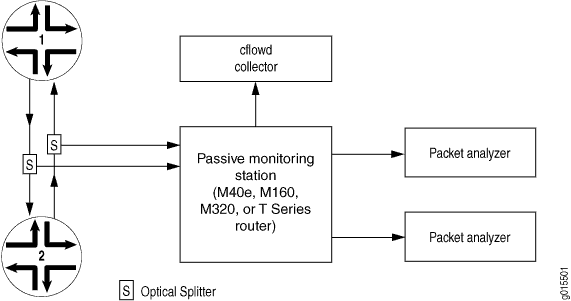Passive Flow Monitoring Overview
Using an MX Series router, a selection of PICs (including the Monitoring Services PIC, Adaptive Services [AS] PIC, Multiservices PIC, or Multiservices DPC) and other networking hardware, you can monitor traffic flow and export the monitored traffic. Monitoring traffic allows you to do the following:
Gather and export detailed information about IP version 4 (IPv4) traffic flows between source and destination nodes in your network.
Sample all incoming IPv4 traffic on the monitoring interface and present the data in cflowd record format.
Perform discard accounting on an incoming traffic flow.
Encrypt or tunnel outgoing cflowd records, intercepted IPv4 traffic, or both.
Direct filtered traffic to different packet analyzers and present the data in its original format (port mirror).
Note:Monitoring Services PICs, AS PICs, and Multiservices PICs must be mounted on an Enhanced Flexible PIC Concentrator (FPC) in an MX Series router.
Multiservices DPCs installed in Juniper Networks MX Series routers support the same functionality, with the exception of the passive monitoring and flow-tap features.
The router used for passive monitoring does not route packets from the monitored interface, nor does it run any routing protocols related to those interfaces; it only receives traffic flows, collects intercepted traffic, and exports it to cflowd servers and packet analyzers. Figure 1 shows a typical topology for the passive flow-monitoring application.

Traffic travels normally between Router 1 and Router 2. To redirect IPv4 traffic, you insert an optical splitter on the interface between these two routers. The optical splitter copies and redirects the traffic to the monitoring station, which is an MX Series router. The optical cable connects only the receive port on the monitoring station, never the transmit port. This configuration allows the monitoring station to receive traffic from the router being monitored but never to transmit it back.
If you are monitoring traffic flow, the Internet Processor II application-specific integrated circuit (ASIC) in the router forwards a copy of the traffic to the Monitoring Services, Adaptive Services, or Multiservices PIC in the monitoring station. If more than one monitoring PIC is installed, the monitoring station distributes the load of the incoming traffic across the multiple PICs. The monitoring PICs generate flow records in cflowd version 5 format, and the records are then exported to the cflowd collector.
If you are performing lawful interception of traffic between the two routers, the Internet Processor II ASIC filters the incoming traffic and forwards it to the Tunnel Services PIC. Filter-based forwarding is then applied to direct the traffic to the packet analyzers.
Optionally, the intercepted traffic or the cflowd records can be encrypted by the ES PIC or IP Security (IPsec) services and then sent to a cflowd server or packet analyzer.
